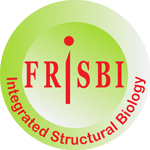FRISBI


FRISBI offers a range of workshops to train graduate and post-graduate students in integrated structural biology. FRISBI courses are open to french and european researchers, from academic and industry.
ReNaFoBis / FRISBI webinar
Please find below the program of the next FRISBI/ReNaFoBis webinar on January 15th at 01:00 PM Paris with 2 speakers
Speaker : Aurélie Bertin PCC UMR CNRS 168 (Physique des cellules et cancer), Institut Curie
Tittle: Cryo-tomography : a useful tool to study membrane remodeling proteins using reconstituted systems.
To investigate the details on how proteins can reshape membranes, we have been using reconstituted in vitro bottom-up systems to control key experimental parameters: proteins involved, lipid composition, ionic environment… Cryo-electron tomography describes in three dimensions how membranes are reshaped and give details on the organization of proteins bound to lipids. I will present several examples, involving filamentous proteins, illustrating the methodology. For instance, I will describe findings considering proteins involved in cell division: septins and ESCRTs.
Speaker : Denis Chrétien Université de Rennes, UMR 6290, équipe MiToS
Tittle : C- and D-lattices: The missing link between microtubule structure and dynamic instability?
Microtubules display a unique dynamic behavior called dynamic instability, wherein they alternate stochastically between growing and shrinking states (Mitchison and Kirschner, 1984). Although this behavior is precisely regulated in cells by a plethora of microtubule-associated proteins, it is an intrinsic property of microtubules assembled from purified tubulin, indicating that it is encoded in their structure and assembly mechanisms. In this study, we identify new types of lateral interactions between αβ-heterodimers, which we term C and D, in continuity with the classical A and B lattices described about 50 years ago (Amos and Klug, 1974). These newly identified interactions are much weaker than the A- and B-types, impose a substantial inward rotation on the two protofilaments involved in these interactions, and may form in response to high protofilament skew to release mechanical stress when the microtubule closes into highly skewed configurations. They are abundant at the onset of microtubule self-assembly where large GTP caps assemble, and in the presence of several slowly hydrolysable GTP analogues, suggesting a tight link between the nucleotide state of tubulin and the formation of these lattices.
Please register here https://us06web.zoom.us/webinar/register/WN_mZzRudr2SLuiraRN1FYogA
BioStine
FRISBI support BioStine a site to access the basics in Structural Biology in French Biostine FR , or in English Biostine EN
Une play-list youtube dédiée à la Biologie Structurale Intégrative (Coordination: Marie-Hélène Le Du, Paris-Saclay): https://www.youtube.com/playlist?list=PLJXFANNaperht_5i-UzBTvCLAH0-CbIg6
Past webinars:
November 20: Speaker: Charles Kervrann, Inria Rennes, Institut Curie, France Tittle: Deep learning and Convolutional Neural Network for Macromolecule detection and Identification in 3D Cryo-Cellular Tomograms. Speaker 2 : Hugues Nury, IBS Grenoble, France Tittle: RDL receptor and the application of AI-guided protein design for developing safer insecticides.
October 16th Speaker : Philippe Carpentier: Laboratoire de Chimie et Biologie des Métaux, DRF/IRIG/CBM, UMR 5249 CEA/CNRS/UGA, CEA/Grenoble, Title: Pressurizing crystals at the HPMX laboratory to unlock the internal architecture, dynamics, and mechanisms of proteins. Speaker: Mael Balanec: I2BC Paris Saclay Title: Structural understanding of site-specific recombination by XerC/XerD in Vibrio cholerae"
September 18 Speaker: Darren Hart, IBS/ISBG Grenoble Title: The French Infrastructure for Integrated Structural Biology (FRISBI) - current status and future plans.
July 10th at 01:00 PM Paris Leandro Estrozi, IBS, Grenoble Title: Helical Symmetry Determination for 3D Cryo-Electron Microscopy and Denis Chrétien, Université de Renes Title: C- and D-type lateral interactions weaken the microtubule lattice
May 15th at 01:00 PM Paris Marc Jamin, IBS, Grenoble, France Tittle: Deciphering the mechanisms of liquid phase separation induced by rabies virus phosphoprotein
April 24 at 01:00 PM Paris Speaker: Simon Pichard, IGBMC/CBI, Illkirch, France Tittle: Eukaryotic production and characterization of multi-protein complexes: tools and examples and Speaker: Amélie Zachayus, IGBMC, France Title: New Models, New Insights: How CRISPR-Cas9 and Live-Cell Analysis can be used to Enhance Our Understanding of Cellular Mechanisms: the example of the transcription/DNA repair factor TFIIH
March 13, 2025 Speaker: Claude Sauter, IBMC, Strasbourg, France Tittle: Microfluidic chips for biomolecular crystal growth and serial crystallography; Serena Sirigu, SOLEIL, Paris-Saclay, France Tittle: In-situ X-ray crystallography with the CRIBLEUR on the PROXIMA-2A beamline at Synchrotron SOLEIL
February 13, 2025 Speaker: Tobias Madl University of Graz, Austria Tittle "Decoding the Regulatory Role of Post-Translational Modifications with NMR Spectroscopy"
January 23, 2025 Speaker: Nils Marechal, IGBMC/CBI, Illkirch, France Title: Streptavidin affinity grids for structural electron microscopy
Please follow our program of ReNaFoBis-FRISBI webinars
FRISBI is involved and strongly support the French National training network in structural biology (ReNaFoBiS). Aimed to be a national PhD training network, ReNaFoBiS coordinate and organize classes, workshops and training programs for students and post-docs.
See http://www.renafobis.fr/ for more information